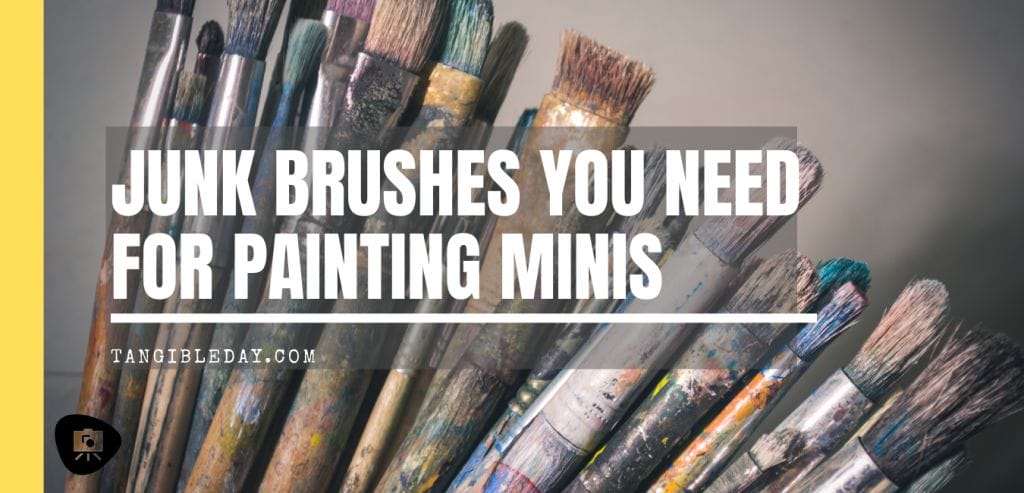Are you looking for cheap, inexpensive brushes for miniature painting? Sometimes you want to neglect your tools and just get to work! Go ahead and abuse your brushes. Paint like nothing else matters. Yes, you absolutely need cheap brushes for painting miniatures. These are the brushes you can treat like crap. Let your imagination run free, and don’t baby your toys. Use them up!
In this article I show you why cheap brushes need to be in your miniature painting toolbox. I also show you some of the abusive things you would NEVER want to do to a high-quality, expensive sable paint brush.
RELATED: WAYS TO PAINT MINIATURES WITH A UNIQUE EXPRESSIVE STYLE
KEY TAKEAWAYS
- Some miniature painting techniques will be rough on your paint brushes, e.g., dry brushing, which is why you’ll want a collection synthetic, inexpensive brushes at some point
- Learn more about how to choose the best synthetic miniature paintbrushes with a highlight of a few recommended inexpensive brush sets
- You can maintain your synthetic brushes using the same brush cleaning methods you would use on more expensive sable paint brushes, or not 😇
Why You Need Cheap Brushes for Painting Miniatures
Art is about capturing the moment. Don’t hesitate, apply your passion and stick those synthetic bristles in oil paint, mineral spirits—splay them across a dirty canvas.
Leave them soaking in a pot of water over night. And, by all means dry brush with them!
Here are 3 reasons why a cheap, synthetic paint brush is important for every miniature painter:
- Synthetic brushes are impervious to abuse (not really, but who cares!).
- Every miniature painter should have some toss-away brushes for a variety of useful reasons.
- Oil painting, glue application, and dry brushing are some of the most common things you can do that would ruin most expensive sable brushes.
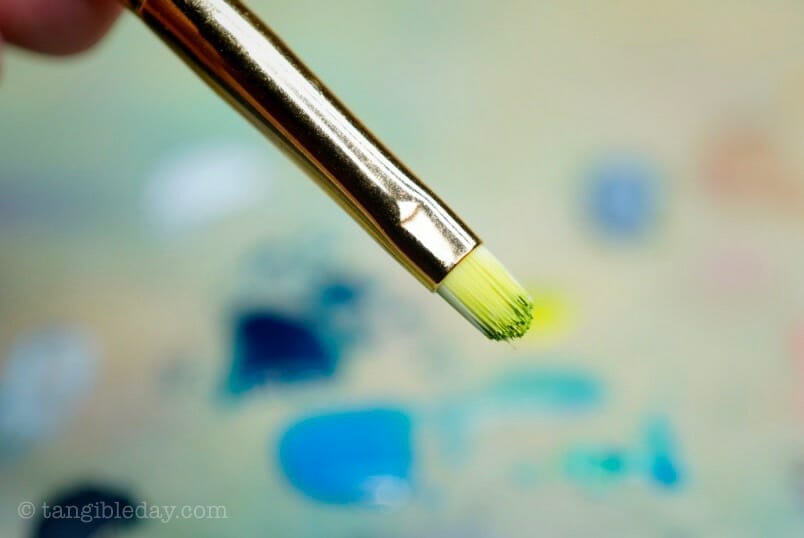
RELATED: GUIDE TO FINDING THE BEST BRUSH FOR PAINTING MINIATURES AND MODELS
5 Ways to Destroy a Paint Brush
Sometimes you can’t avoid doing things with your paint brushes that end up killing them. A lot of the tools in our miniature painting hobby are expensive.

If you’re a scale modeler, or work with miniatures and gaming models, then you know how damaging some of the chemicals we use are. Glues, adhesives, and general cleaning agent wreak havoc on the delicate parts of our brushes.

Have you ever left a paint brush in your cleaning water pot, bristle side down? I have. And, it sucks. The result is loosened bristles, and swollen wooden handles with a metal ferrule coming off at the slightest touch. Well, this is an example of a preventable action. Oops.
But, there are things we NEED to do to get the job done.
RELATED: 10 RECYCLING HACKS FOR OLD, WORN OUT PAINT BRUSHES
Here are Top 5 Harmful Things You Do to Your Brushes
1. Glue Application with a Brush
Every miniatures painter needs a set of inexpensive, low-cost brushes that they can misuse and toss away. I’ve been known to use these cheap brushes for applying white glue for building terrain. Water soluble glue is great for basing miniatures. And, the easiest way to spread glue on a model’s base is with a paint brush. Really, they are perfect for this job!
Get any kind of glue on your miniature bases or terrain pieces. Because synthetic brushes are easy to clean with harsher methods, and you could care less about their ultimate shape (e.g., you don’t need them to stay pointy and sharp; all you need is for the brushes to get “art medium ‘x’” to “surface ‘y’”).
RELATED: BEST GLUES FOR PLASTIC, METAL, AND RESIN MODELS
PVA, or white glue, is usually cleaned off a brush with soap and water. Hot water may be useful, but a good scrubbing with running water will take off most of the glue.
Avoid super glue on any brush as that stuff is an insta-brush killer (trust me, I’ve lost quite a few brushes to uncured super glue getting onto bristle tips). The only way to recover a brush is to snip off the glued tips with a scissor. On the bright side, that’s how a dedicated dry brush is born.
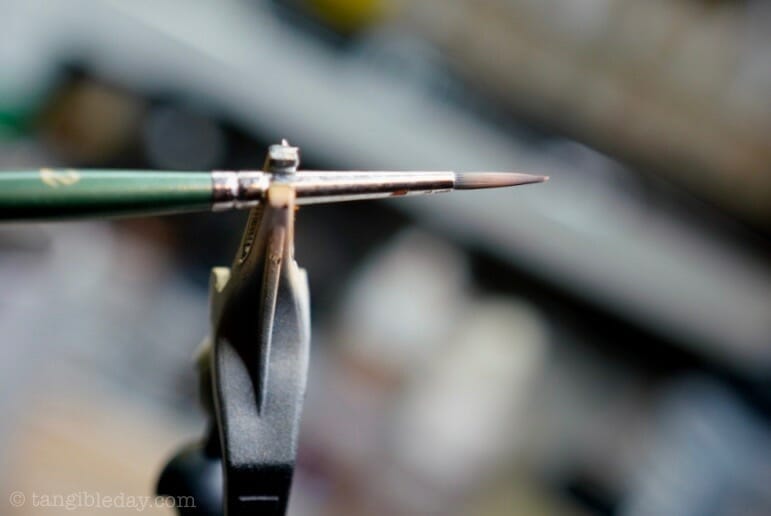
2. Oil Paints
I paint miniatures with oil colors, which requires the use of some nasty solvents (see an example here). This includes clear mineral spirits and turpentine. Both of these chemicals would destroy a natural hair brush. Oil paints are incredibly useful in acrylic miniature painting. They work great over a solid base of acrylic paint as either a color modulator (look up “dot filters”), or as a darkening wash to increase contrast.
I apply oil paints using various synthetic nylon brushes with different shapes. For dot filter applications, I use small stiff brushes with the point tips, and for washes, I like using larger brushes with a belly (to hold more paint). You can see one of my favorite miniatures painted with oil paints.

3. Dry Brushing
Good dry brushing technique is great for painting miniatures. Here’s a guide for how to dry brush models. The dry brush technique easily adds contrast (which is key for speed painting miniatures here). But, good dry brushing technique also DESTROYS fragile brushes. Friction and pressure against a miniature is horrifying for any natural sable paint brush.
For this dry brushing, I find using cheap cosmetic brushes are the best. You can find great cosmetic brushes for under $1 per brush. I’ll say it again: One of the biggest reasons I keep synthetics on my hobby desk is that I can use them for tasks that would damage my expensive sable brushes I use for painting details.

4. Liquid Masking
Do you airbrush miniatures? There are several advantages to airbrushes versus regular brush work. For one thing, you can use fun techniques with stencils to create unique textures, patterns, and cool special effects on miniatures.
For other masking techniques, beyond using sticky tack or painter’s tape, you can use liquid frisket on a miniature. Vallejo Liquid Mask fluid is made of a latex that dries fast. It has a sticky-glue like characteristic, which is easily removed from miniatures after painting. But, when masking fluid clings and dries to the filaments of a brush, it’s impossible to clean off!
A trick I use to apply masking fluid to a miniature is to first dip your brush in liquid hand soap. I put some soap in a ceramic palette and just dip my cheap brush in it before using masking fluid. The soap prevents the masking fluid from sticking to the brush bristles. When you’re finished applying the mask to the miniature, simply wash off the soap along with the clinging masking fluid. This keeps the brush going strong.
Even with care and a thorough washing, masking fluid will render any brush useless for regular detail-type painting. Use a cheap synthetic brush to apply masking fluid and you avoid the hassle of worrying about how to clean it off. Also, synthetic brushes are easier to use than disposable solutions for applying masking fluid (e.g., toothpicks, cotton tipped applicators).
5. Brush-on Primer
Priming a model is one of the most important early steps in miniature painting.
Priming miniatures is best done with an airbrush or aerosol primer. That is how you get the even, thin coats on a model that make the subsequent paint job much easier. You’ll even get better miniature painting results with a good primer application. But, if you don’t have an airbrush or want to avoid the issues of using a rattle spray can primer, e.g., aerosol, then you’ll have to brush it on.
By the way, Vallejo Surface Primer is my favorite primer for painting miniatures. It works great with an airbrush or regular brush. To apply a brush-on primer, use a cheap synthetic brush.
You’ll preferably want to use a flat headed brush that allows you to apply abundant amounts of primer and spread it around efficiently. Have fun! You don’t need to worry about the brush. Make sure the primer gets into the deep recesses and crevices. Brush the primer onto rough, textured surfaces.
The great thing about using a low-cost paint brush for priming is that you don’t need to worry about the bristles. As long as you apply the primer evenly, over every surface, you’ve done your job.

How to Clean a Synthetic Brush?
Here are 3 ways for how to efficiently and quickly clean your cheap synthetic brushes:
- Use hot water
- Harsh solvents
- Ultrasonic cleaner
Warning: Don’t do this with expensive brushes!
Option #1 – Use Hot Water
How hot? You can use boiling water (212F or 100C) to clean your synthetic brushes. In fact, the use of hot water may help you retrain the shape of your synthetic brushes. The horror of hot water for normal brushes is that it can melt the glue off from under the metal ferrules making the bristles fall out. However, with synthetic brushes, especially nylon brushes this isn’t a huge problem.
First, the bristles are usually “clamped” into the ferrule so they are held in by more than glue. Second, you can actually glue back the ferrule or even loose bristles! Or you, this is kind of the bonus idea, you can throw out your RUINED brushes (cuz they are so dang cheap!)
Option #2 – Apply Harsh Solvents
Sometimes you might have to use a strong solvent to clean your brushes. Oil paints require mineral spirits or turpentine to clean off. Soap or strong detergents can also help for the more thorough cleaning. I’ve heard that nylon brushes can be cleaned very easily with alcohol (90% or greater rubbing alcohol or denatured alcohol). After using alcohol you can dip those brushes in the boiling water to reshape them. Cool, yeah?
Option #3 – Ultrasonic Cleaner
You can submerge your soiled brushes in an ultrasonic cleaner. Crazy, right? It works though. An ultrasonic cleaner is a bath of water (or other fluid you put in it) that emits very high frequency sound waves to agitate the objects in the bath. The sound waves produce bubbles that “scrub” whatever you’re trying to clean (more info).
An ultrasonic cleaner is very effective for airbrushes. I use mine a lot for this purpose, too. But, I also found it’s great for some of my synthetic brushes. It’s quickly gets rid of the larger, caked-in, paint and pigments in the bristles that I can reach with normal manual scrubbing under running water. Then, if I need to, I follow up with the methods above.
It’s lazy, it’s harmful to the brushes, but again…synthetic cheap brushes make this a convenient option.
RELATED: SIMPLE BRUSH CLEANING TIPS FOR EVERY MINIATURE PAINTER
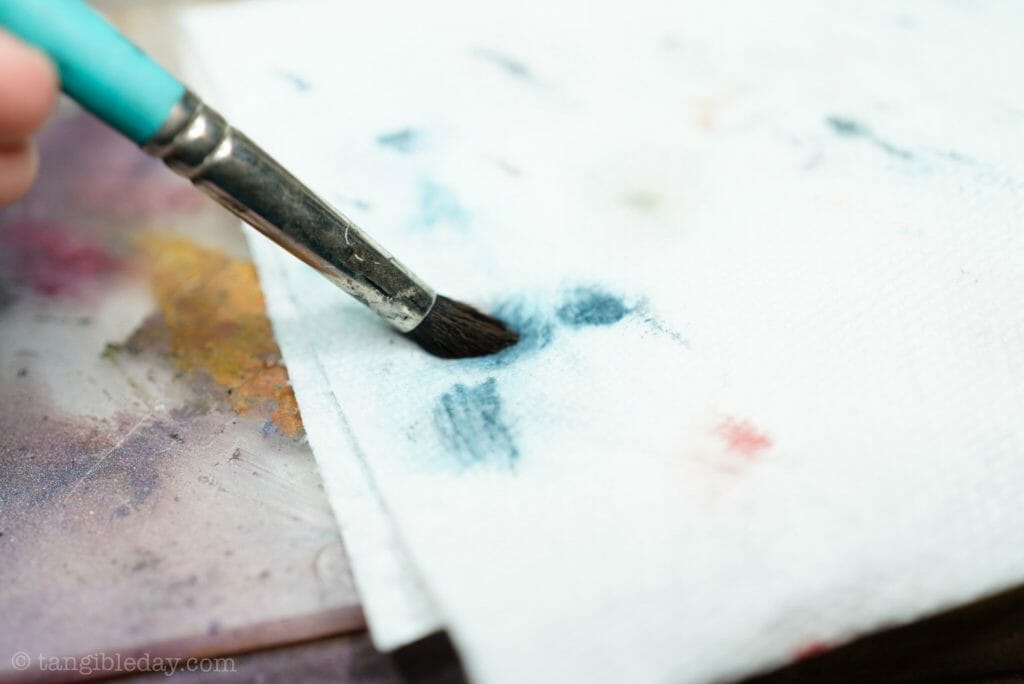
READ MORE: YAY OR NAY? AN ARMY PAINTER “REGIMENT” BRUSH REVIEW
What About the Environment? Are Synthetic Brushes Sustainable?
Every paint brush you use for the miniature and model painting hobby is a “consumable”. At the end of the service life of a paint brush, you can try to recycle them (here are 10 ways to recycle old brushes) or throw them away.
The great thing about synthetic brushes over other applicators is that synthetic brushes can withstand re-use despite the abuse you throw at them. You can clean them with the methods described above and they will keep on working for you. Again, there are more ways to use an old brush than you think. If you missed the recycling link above, here it is again (link).
A synthetic brush can last months or years despite some serious abuse. Unlike natural sable brushes, synthetic brushes have bristles that are resilient to harsh chemicals, cleaning agents, and aggressive scrubbing. YOU DECIDE when the brush is “dead”.
If it continues to do the job, you can keep using that brush. So ultimately, a single synthetic brush will take the place of hundreds of cotton-tipped buds, wooden or plastic applicators, or other disposable solutions. Yes, in many ways, using a synthetic brush is a more sustainable, environmentally friendly way to approach your hobby.
Recommended Cheap Brushes (My TOp 3 Picks)
Here are three budget brush sets that are great to have when you need brushes that you can use for any hobby task.
Synthetic Hair Paint Brushes (Set of 10)

I bought this set at a local art store (Hobby Lobby). It comes in a pack of 10 various-shaped brushes. I think they are made of nylon, I’m not sure. But, they are stiff bristles which makes them ideal for applying glue for basing, or for using brush on primer.
I’ve these brushes to apply oil washes, but find that they don’t hold a good amount of liquid. You’ll need to reload your brush with paint often. On the other hand, these brushes are easy to clean. Some of these brushes are also great for your kids and double as arts & craft brushes for various stay at home projects.
Make Up Cosmetic Brush Set (24 Piece Set)
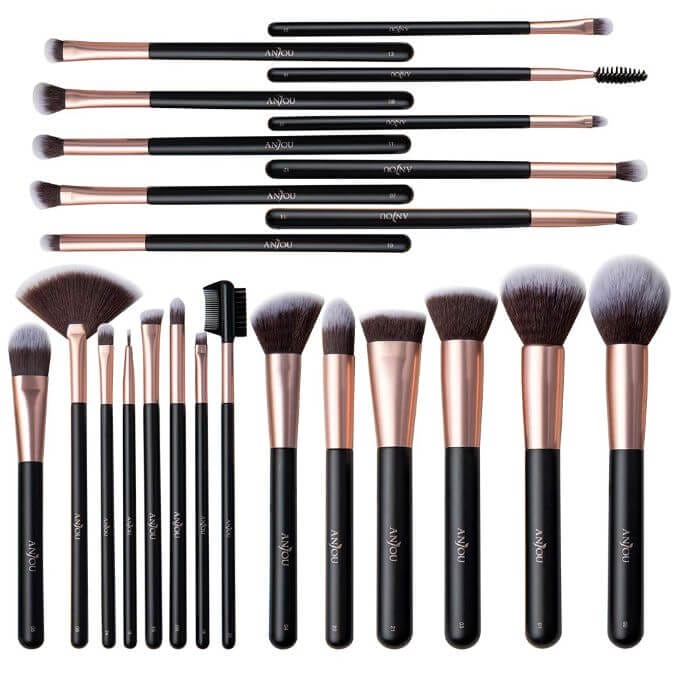
As you can tell, I go for those paint brush sets that have a variety of paint brush shapes. That’s because at some point in my miniature painting work I’ll find the need for a specific shaped-applicator. The broader brushes are really good at applying medium or paints to large surfaces, or getting a good volume of wash onto a model quickly. Those kinds of brushes are also really good as dry brushes for the larger models I work on.
The smaller synthetic brushes are useful for glue application in tight spots like around the feet of a miniature. Small brushes are also great for dry brushing hard-to-reach areas on a model.
I find cosmetic brushes to be excellent for a variety of uses because they are soft and flexible. They carry a good amount of paint (acrylic or oil) and clean up nicely with soap and hot water. As you can tell with this set, some of them have really large bellies (an important brush feature!)
The larger brushes in the set work well as for applying huge amounts of art medium to a model (e.g., primer and washes). Of course, this is a really inexpensive set at less than $0.75 per brush. If you ruin one, not only did you not spend a lot, but you have a bunch more in the set ready to go!
Don’t ask me what the mascara brush is good for. Maybe, you can use it in sculpting texture in polymer clay?
Artist Round Watercolor Paint Brushes Set (Set of 12)
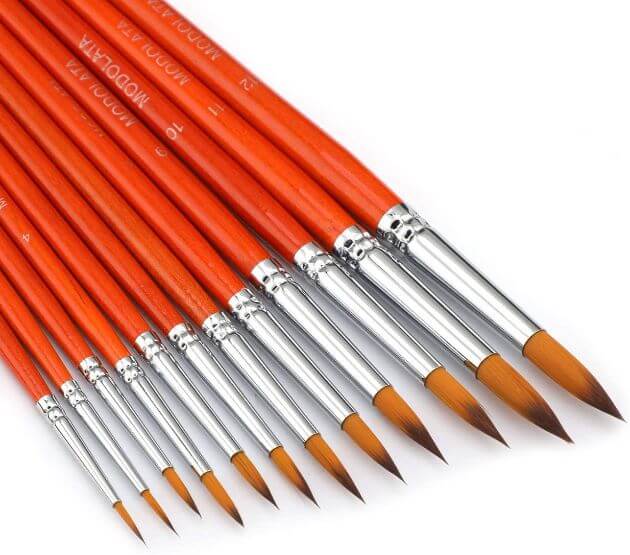
These are one of the best deals I’ve found for synthetic pointed round-shaped brushes. These are brushes price out to about $0.50 per brush. There are a variety of sizes here, but most of them are within the range you’d want for more precise miniature painting work.
Of course, with this lower cost, you also probably get brushes that lose their shape easily. But, if you follow some of the instructions above about keeping your brushes clean, using alcohol and boiling hot water to reshape the tips, then you should be able to get some really good use out of these.
The best part about pointed-round shaped brushes is their versatility. So, I know these would be useful for all sorts of things that you could do with a more expensive sable brush (with some limitations).
Generally, I like have these around also because I don’t need to baby them if I’m traveling with my paint kit, or want to roam and use a different room in the house for painting work (i.e., the kitchen table). If I forget to leave the brush somewhere, or if my two year old gets a hold of them, no worries. These are expendable. Just relax, keep painting, and have fun!
Conclusion
Obviously, with any hobby tools, there isn’t a best kind or type. It’s your personal preference. As a principle, having cheap tools around can be a huge boon as your productivity isn’t reliant on the need to keep things in tip-top shape. Just roll with your instincts to get something done.
Cheap synthetic brushes fill a versatile slot in your hobby toolkit. Although you can get more precise quality work done with more expensive sable brushes, there are times when you need brute force.
Cheap synthetic brushes are the expendable grunts, the cannon fodder, that protect the expensive hardware from the literal dirty work. Art is about moments, but creating art is a battle. Prepare for casualties!
And, happy painting!




Tangible Day on YouTube (Miniatures and More!)

